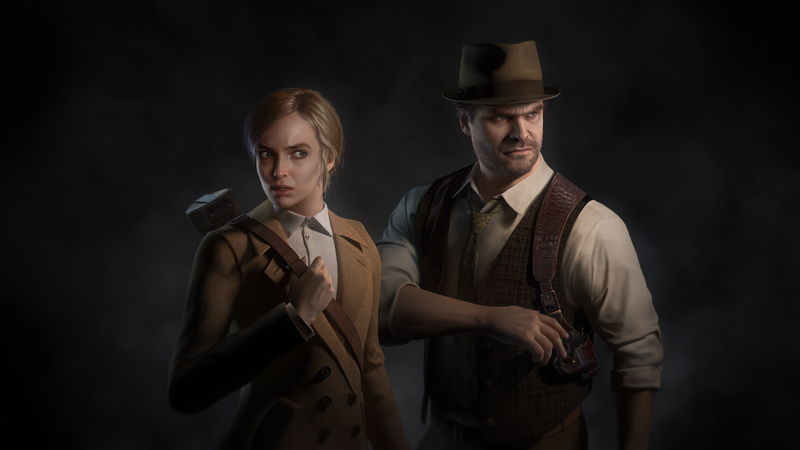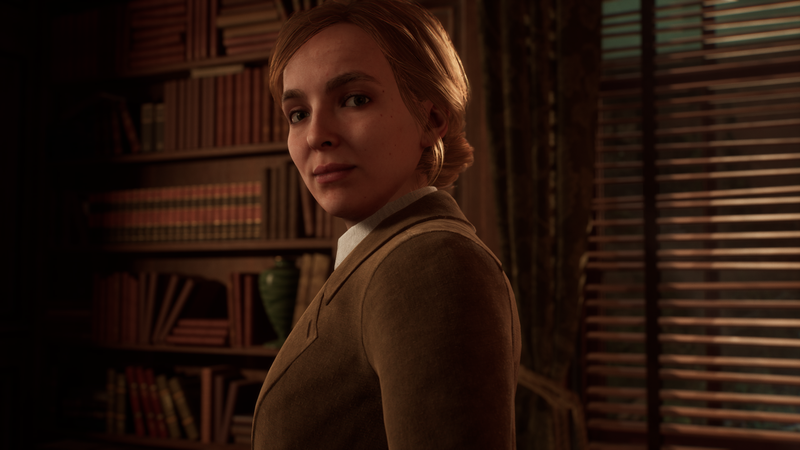Alone In The Dark review: David Harbour is the worst part of this horror game remake

- Oops!Something went wrong.Please try again later.
Can you create an effective psychological horror story when your main character constantly sounds like he’s psychologically inert? That’s the question raised by the new horror game Alone In The Dark, which, despite both its title and some occasional clever jokes alluding to it, owes as much to the lesser entries in the Silent Hill and Resident Evil horror franchises as it does the 1992 horror gaming classic of the same name.
AITD puts one of its biggest selling points—and secret weaknesses—right on the title screen, in the form of its digitally captured stars, Jodie Comer and David Harbour. As mystery-solving duo Emily Hartwood and detective Edward Carnby, the pair travel to the swampy Louisiana manor of Derceto, a former plantation home now converted into an asylum for some of the more inconvenient members of 1920s New Orleans society—most notably Emily’s uncle Jeremy, who’s tortured by visions of supernatural evil with a nasty knack for coming true on Derceto’s haunted grounds. Your first major choice in the game, then, is which of your Big TV Stars will be your main character, experiencing various jump scares and five-second creep-outs while the other one spends the evening puttering placidly around the mansion; having watched more Stranger Things than Killing Eve, we chose Carnby—only to be reminded, both immediately, and relentlessly, of why voice actor is a very specific, and very talent-heavy job that a big-name star can’t automatically cover for just by being rather famous.

Alone In The Dark
Alone In The Dark
Developer
Pieces Interactive
Publisher
THQ Nordic
Platforms
PlayStation 5, Windows, Xbox Series X/S
Reviewed On
PlayStation 5
Rating
M
Which is to say—and with no ill will held toward Harbour, a talented actor we’ve enjoyed in a number of parts—that the only times he doesn’t sound like he’s sleepwalking while portraying Carnby come after the player holds the game’s sprint button down for too long, forcing the poor bastard to hack and wheeze for several seconds before catching his breath. What we played of Emily’s version of the story—the two games are largely similar, with only occasional deviations—suggests Comer is a bit better at infusing some genuine horror into her voice work, but neither star is a natural in the recording booth—especially when contrasted with the rest of the game’s cast, who know that “big” works better than “small” when you’re acting in video game horror. And given that these two performances are your major window into Alone In The Dark’s retread of the story of the original game, that’s a hell of a demerit.
As to the actual play of Alone In The Dark, it’s divided pretty evenly into non-combat and combat sections—or, as we came to think of them, during our 10 or so hours with the game, into the good stuff, and the crap. Exploring Derceto is actually kind of a kick: It’s a gorgeous old house, full of creepy corners and interesting puzzles, and the parts of AITD that most closely resemble old-school adventure games, hunting for keys, fiddling with mechanisms, talking to residents, etc., are some of its best portions. The other parts, meanwhile, largely involve traveling into mental worlds conjured up by Jeremy’s tortured psyche, which are filled with generic swamp monsters that you will listlessly shoot in the head with one of the game’s four guns about half a dozen times before scavenging ammo from the environment so you can repeat the chore a few minutes later. Combat in Alone In The Dark ranges, depending on environment, enemy types, and available weapons, from entirely forgettable to actively frustrating; it doesn’t help that the game’s finicky over-the-shoulder camera occasionally went into convulsions during certain enemy attacks, giving us a highly informative view of a room’s distant wallpaper whilst a gigantic tick was humping Harbour’s digital face with gusto.

And yet—despite its general track record as a horror game that can only startle, and never scare—there are moments when Alone In The Dark’s storytelling actually managed to get to us. Admittedly, most of these were outright stolen from the public domain, pulling liberally from the Cthulhu Mythos to infuse Derceto and its environs with a creeping strain of horror that none of the game’s actual monsters can provide. But even so, the idea of a modern video game remake where you seriously have to contend with the fell planning of, say, Nyarlathotep does carry a certain welcome novelty, especially when the game tries to get some more Lovecraftian locations actually on the screen. And, as the game turns up the intensity of its psychological onslaught on the characters, Harbour and Comer get at least a bit more to sink their teeth into, making the back half of Alone In The Dark a better experience than the front. (The dividing line, as it happens, is one of those aforementioned mental worlds—a sunlit library that serves as the home of the game’s sole intimidating piece of enemy design.)
There’s a good game lurking somewhere underneath Alone In The Dark, sinking into a swamp of unnecessary extraneous systems and lackluster performances. At the risk of Monday morning quarterbacking, we find ourselves wishing it didn’t have a combat system—or, at least, this combat system—at all, instead focusing solely on investigating the spooky mansion and the occasional jaunt into extradimensional spaces. It’s briskly paced, its puzzles occasionally require an actual modicum of thought, and some of the horror ideas it’s trafficking in carry legitimate power. Don’t expect wading through all the dross to get to the good bits to be anything less than a trip into madness, though.

